Scientific classification
Kingdom:
Phylum:
Arthropoda
Class:
Malacostraca
Order:
Decapoda
Family:
Grapsidae
Genus:
Grapsus
Species:
G. Adscensions
Binomial name (link Wikipedia)




Lichtfoot Crab
Crabe Rouge
Rote Felsen-Krabbe
Cangrejo Moro
Rode Rots Krab
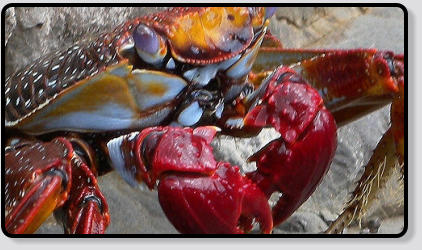
Description
Grapsus grapsus is one of the most common crabs along the western coast of the Americas. It is known variously as, "red rock crab", "abuete
negro", and along with crabs such as Percnon gibbesi as, "Sally Lightfoot"
Grapsus grapsus is a typically shaped crab, with five pairs of legs, the front two bearing small, blocky, symmetrical chelae. The other legs are
broad and flat, with only the tips touching the substrate. The crab's round, flat carapace is slightly longer than 8 centimetres (3.1 in). Young G.
grapsus are black or dark brown in colour and are camouflaged well on the black lava coasts of volcanic islands. Adults are quite variable in
colour; some are muted brownish-red, some mottled or spotted brown, pink,or yellow.
Grapsus grapsus is found along the Pacific coast of Mexico, Central America, South America (as far south as northern Peru), and on nearby
islands, including the Galápagos Islands. It is also found along the Atlantic coast of South America, but is replaced in the eastern Atlantic Ocean
(Ascension Island and West Africa) by its congener Grapsus adscensionis.

Animalia
Scientific classification
Kingdom:
Phylum:
Arthropoda
Class:
Malacostraca
Order:
Decapoda
Family:
Plagusiidae
Genus:
Species:
P. Depressa
Binomial name (link Wikipedia)




Grey Rock Crab
Crabe gris
Graue Felsen-Krabbe
Cangrejo Blanco
Grijze Rots Krab
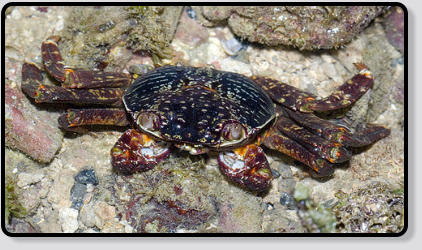
Description
Plagusia is a genus of crabs in the family Plagusiidae, containing the following species:
Plagusia depressa (Fabricius, 1775)
Plagusia immaculata Lamarck, 1818
Plagusia integripes Garth, 1973
Plagusia speciosa Dana, 1852
Plagusia squamosa (Herbst, 1790)
No further information available on Wikipedia.
Animalia
Scientific classification
Kingdom:
Phylum:
Arthropoda
Class:
Malacostraca
Order:
Decapoda
Family:
Xanthidae
Genus:
Xantho
Species:
X. Sp.
Xantho Sp.
Binomial name




Blue Strongbox
Crabe Bleu
Blaue Panzerkrabbe
Carnada de Vieja
Blauwe Krab
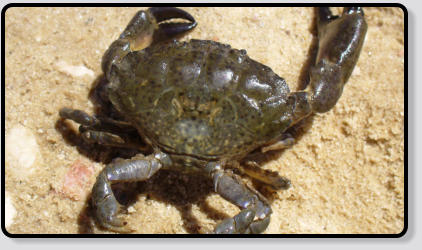
Description
Xantho Sp. is a species of crab from the Black Sea, Mediterranean Sea and parts of the eastern Atlantic Ocean. It is one of four species in the
genus Xantho.
Juveniles live in Posidonia meadows until their last moult, at which point they migrate to the nearest rocky substrate
No further information available on Wikipedia.
Animalia
Scientific classification
Kingdom:
Phylum:
Arthropoda
Class:
Crustacea
Order:
Decapoda
Family:
Grapsidae
Genus:
Pachygrapsus
Species:
P. Sp
Pachygrapsus Sp.
Binomial name




Arock Crab
Pachygrapsus Sp.
Pachygrapsus Sp.
Juyón
Rots Krab

No further information available on Wikipedia.
Description
Animalia
Scientific classification
Kingdom:
Phylum:
Arthropoda
Class:
Malacostraca
Order:
Decapoda
Family:
Percnidae
Genus:
Percnon
Species:
P. Gibbesi
Binomial name (link Wikipedia)




Flat Crab
Arraignée
Flachkrabbe
Araña
Platte Krab

Percnon gibbesi is a species of crab. It is one of at least two species commonly called "Sally Lightfoot" (the other being the semi-terrestrial
Grapsus grapsus from the Pacific coast of the Americas), and is also referred to as the nimble spray crab or urchin crab. It has been described as
"the most invasive decapod species to enter the Mediterranean"
Adults have a carapace 30 millimetres (1.2 in) wide, and legs with yellow rings at the joints. Each of the five pairs of walking legs has a row of
spines along the leading edge. Females carrying eggs have been caught off West Africa between February and April and August; the larvae
which hatch from them are planktonic and long-lived, which may contribute to the species' invasiveness.
P. gibbesi is one of the most widespread grapsid crabs, being found on both sides of the Atlantic Ocean and on the Pacific coast of North
America. There, its range extends from California to Chile, while in the Atlantic, it occurs natively from Florida to Brazil and from Madeira to the
Gulf of Guinea. It has recently invaded the Mediterranean Sea, having first been discovered at Linosa, Sicily in 1999. It has subsequently been
found on the Balearic Islands, in Greece, in Libya in Malta and in Israel.
Description
Animalia
Scientific classification
Kingdom:
Phylum:
Arthropoda
Class:
Malacostraca
Order:
Decapoda
Family:
Dromiidae
Genus:
Dromia
Species:
D. Sp.
Dromia Sp.
Binomial name




Atlantic Sponge Crab
Dromia Sp.
Atlantische Wollkrabbe
Cangrejo Esponja
Atlantische Sponskrab
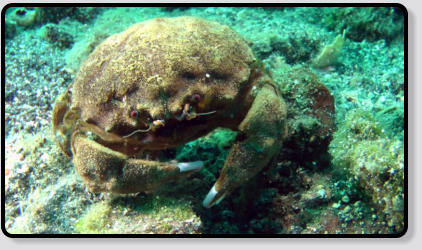
No further information available on Wikipedia.
Description
Animalia





Harry van Goor 2016
source: Wikipedia, the free encyclopedia


Categories: Crabs
Scientific classification
Kingdom:
Phylum:
Arthropoda
Class:
Malacostraca
Order:
Decapoda
Family:
Porcellanidae
Genus:
Porcellana
Species:
P. Platycheles
Binomial name (link Wikipedia)




Hairy Crab
Crabe Poilu Porcelaine
Behaarte Porzellan Krabbe
Cangrejo Porcelana
Harig Porseleinkrabbetje
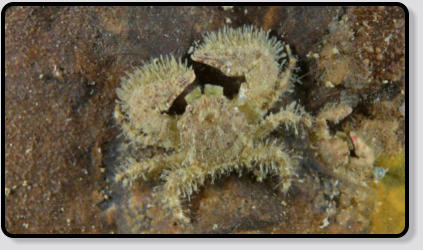
Porcellana platycheles, sometimes called the broad-clawed porcelain crab, is a species of porcelain crab. It may reach a size of 15 millimetres
(0.59 in), and is found in the Eastern North Atlantic Ocean and Mediterranean Sea. It is a filter-feeding crab and it feeds on carrion and other
organic debris.
No further information available on Wikipedia.
Description
Animalia

Scientific classification
Kingdom:
Phylum:
Arthropoda
Class:
Malacostraca
Order:
Decapoda
Family:
Calappidae
Genus:
Cryptosoma
Species:
C. Cristatum
Binomial name (link Wikipedia)




Cryptosoma Cristatum
Cryptosoma Cristatum
Cryptosoma Cristatum
Cryptosoma Cristatum
Cryptosoma Cristatum
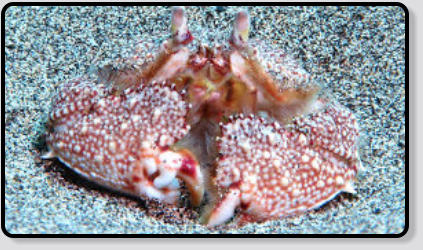
There is no name for this crab known.
No further information available on Wikipedia.
Description
Animalia

Scientific classification
Kingdom:
Phylum:
Arthropoda
Class:
Malacostraca
Order:
Decapoda
Family:
Inachidae
Genus:
Inachus
Species:
I. Phalangium
Binomial name (link Wikipedia)




Leach's Spider Crab
Crabe Anémone Fantôme
Anemone-gespensterkrabbe
Cangrejo de Anémona
Gladde Sponspootkrab
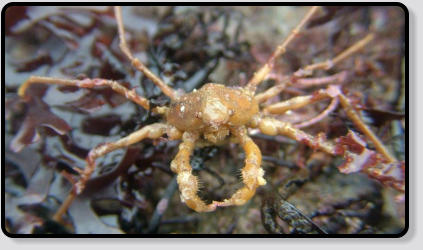
This crab is in English also called Anemone Spider Crab or Leach's Spider Crab called.
Inachus phalangium, Leach's spider crab, is a species of crab from the north-eastern Atlantic Ocean and Mediterranean Sea. It is up to 20.5 mm
(0.81 in) wide, and is very similar to other species in the genus Inachus.
Large males may reach a carapace size of 20.5 by 17.5 millimetres (0.8 in × 0.7 in), and is brownish-yellow in colour. The carapace becomes
narrower towards the front of the animal, and is often concealed by epibionts. I. phalangium resembles the closely related species Inachus
dorsettensis, but has less prominent spines on the carapace.
I. phalangium is found in the eastern Atlantic Ocean, from Norway in the north to West Africa and the Cape Verde islands in the south, and
extending into the Mediterranean Sea. It lives at depths of 11–55 metres (40–180 ft).
Description
Animalia

Scientific classification
Kingdom:
Phylum:
Arthropoda
Class:
Malacostraca
Order:
Decapoda
Family:
Portunidae
Genus:
Portunus
Species:
P. Hastatus
Binomial name (link Wikipedia)




Grey Swimming Crab
Portunus Hastatus
Grey Schwimmerkrabbe
Cangrejo Cornudo
Grijze zwemkrab
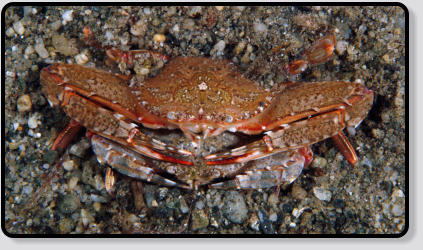
Portunus is a genus of crab which includes several important species for fisheries, such as the blue swimming crab, Portunus pelagicus and the
Gazami crab, P. trituberculatus. Other species, such as the three-spotted crab (P. sanguinolentus) are caught as bycatch.
Fossil of Portunus convexus
The genus Portunus contains more than 90 extant species and over 40 further species known only from fossils.[4]
Fossils of crabs within this genus can be found in sediment of Europe, the United States, Mexico, Venezuela, Brazil and Australia from
Paleogene to recent (age range: 48.6 to 0.0 million years ago).
No further information available on Wikipedia.
Description
Animalia

Scientific classification
Kingdom:
Phylum:
Arthropoda
Class:
Malacostraca
Order:
Decapoda
Family:
Xanthidae
Genus:
Platypodiella
Species:
P. Picta
Platypodiella Picta
Binomial name




Harlequin Crab
Crabe Arlequin
Harlekin Krabbe
Cangrejo Arlequín
Harlekijn Krab
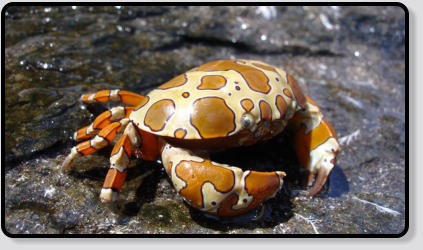
No further information available on Wikipedia.
Description
Animalia

Scientific classification
Kingdom:
Phylum:
Arthropoda
Class:
Malacostraca
Order:
Decapoda
Family:
Grapsidae
Genus:
Planes
Species:
P. Minutus
Binomial name (link Wikipedia)




Columbus Crab
Crabe de Columbus
Columbus-Krabbe
Cangrejo de colon
Columbuskrab
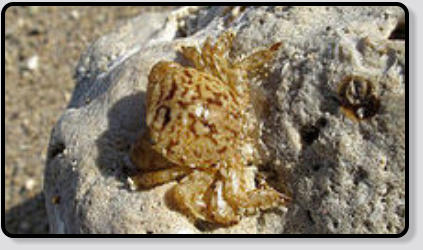
Planes minutus is a species of pelagic crab that lives in the North Atlantic Ocean. It is typically less than 10 mm (0.4 in) long across the back, and
is variable in colouration, to match its background. It may have been the crab seen by Christopher Columbus on Sargassum weed in the
Sargasso Sea in 1492.
Planes minutus is a small crab, reaching a maximum carapace length of 17.5 millimetres (0.7 in), and typically less than 10 mm (0.4 in). It has
conspicuous eyes in wide orbits at the corners of the wide front edge of the carapace. The first pair of pereiopods (walking legs) bear a
symmetrical pair of chelae with cutting teeth; the other four pairs are adorned with spines on the last two segments of each leg. It differs from the
larger P. major in that males have a broadly triangular abdomen, rather than one which narrows abruptly after the third segment, and from P.
marinus in having flattened legs with a fringe of setae that aid in swimming.
The colouration of Planes minutus is very variable, and camouflages the crab against the Sargassum weed it often lives on. The base colour is
typically brown, sometimes tending towards yellow or red. This is often supplemented with large patches of white, apparently imitating the
calcareous tubes attached by annelid worms to Sargassum. Although the colour pattern tends to match that of the substrate on which the crab is
found, the colouration is only able to change slowly after a change of substrate.
Planes minutus is found in the North Atlantic Ocean, between the latitudes of 11° N and 32° N, and also from the west coast of Africa.
Description
Animalia

Scientific classification
Kingdom:
Phylum:
Arthropoda
Class:
Malacostraca
Order:
Decapoda
Family:
Pilumnidae
Genus:
Pilumnus
Species:
P. Sp.
Pilumns Sp.
Binomial name




Hairy Crab
Crabe Poilu
Wuschelkrabbe
Cangrejo Peludo
Ruig Krabbetje
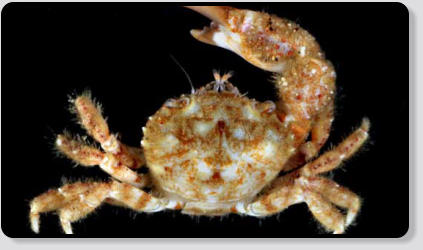
No further information available on Wikipedia.
Description
Animalia

Scientific classification
Kingdom:
Phylum:
Arthropoda
Class:
Malacostraca
Order:
Decapoda
Family:
Majidae
Genus:
Maja
Species:
M. Squinado
Binomial name (link Wikipedia)




Spiny Spider Crab
Araignée de Mer Épineux
Große Seespinne
Crabe-Santorra
Grote Spinkrab
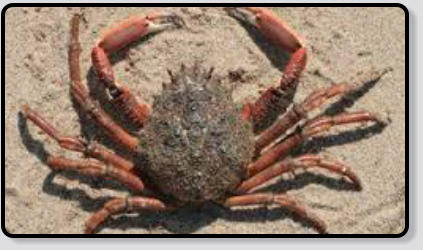
Maja squinado (the European spider crab, spiny spider crab or spinous spider crab) is a species of migratory crab found in the north-east Atlantic
and the Mediterranean Sea.
M. squinado feeds on a great variety of organisms, with seaweeds and molluscs dominating in winter, and echinoderms such as sea urchins and
sea cucumbers in summer.
Migrations generally take place in autumn, with some crabs covering over 100 miles (160 km) in eight months. All crabs are vulnerable to
predation when moulting, and M. squinado becomes gregarious around that time, presumably for defense against predators. Females can
produce up to four broods per year.
Description
Animalia

Scientific classification
Kingdom:
Phylum:
Arthropoda
Class:
Malacostraca
Order:
Decapoda
Family:
Inachidae
Genus:
Stenorhynchus
Species:
S. Lanceolatus
Binomial name (link Wikipedia)




Arrow Crab
Grabe Arraignée
Lanzett-Gespensterkrabbe
Cangrejo Araña
Pijlkrap

Description
Stenorhynchus is a genus of marine crabs in the family Inachidae, containing the following species:
No further information available on Wikipedia.
Animalia

Plagusia














